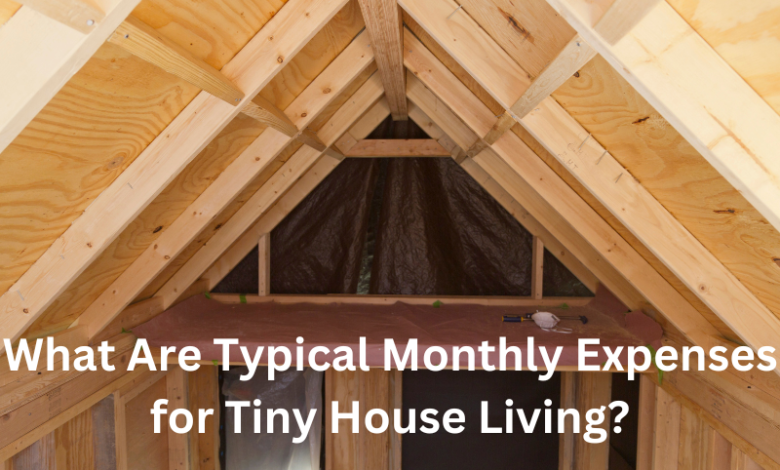What Are Typical Monthly Expenses for Tiny House Living?

When it comes to tiny house living, did you know that the average monthly expenses can vary greatly depending on factors like location and lifestyle choices? Understanding the breakdown of typical costs can help you make informed decisions and effectively manage your finances in this unique living situation. From construction loan payments to set aside funds for unexpected emergencies, each expense plays an important role in maintaining a sustainable and fulfilling tiny house lifestyle. Explore further to uncover the key elements that contribute to your monthly budget and how to navigate them efficiently for a more secure financial future.
Key Takeaways
- Utility expenses include electricity, heating, and water management costs.
- Property taxes vary based on property value and location.
- Maintenance and repair budgeting is crucial for upkeep.
- Internet and communication services impact monthly expenses.
- Emergency funds are vital for unforeseen costs and stability.
Cost of Tiny House Construction
Calculating the cost of constructing a tiny house involves careful consideration of materials, labor, and design choices. Building materials sourcing is essential, with options ranging from reclaimed wood to eco-friendly alternatives.
The construction timeline varies based on complexity and size, but typically ranges from a few months to a year. Design customization allows you to personalize your tiny house to suit your needs, whether that be a minimalist approach or a cozy, rustic cabin feel.
Interior decorating choices can greatly impact the overall cost, from high-end fixtures to budget-friendly alternatives. By carefully planning and budgeting for these aspects, you can make sure that your tiny house construction stays within your financial means while still achieving the aesthetic and functionality you desire.
Utility Expenses
Let’s talk about the utility expenses associated with tiny house living.
When it comes to power costs, you’ll need to take into account electricity for lighting, heating, and any appliances you use.
Water and waste management are also key aspects to budget for, including water usage, sewage disposal, and potentially propane or other fuel sources for heating water and cooking.
These utility expenses are important factors to take into consideration when planning for the monthly costs of living in a tiny house. learn more about tiny homes for sale in victoria.
Power Costs
Power costs for tiny house living can vary depending on factors such as location, energy usage habits, and the type of power sources utilized. Many tiny house dwellers opt for solar panels to harness renewable energy and enhance energy efficiency. For those embracing off-grid living, understanding different power sources and their costs is essential. Below is a table outlining some common power sources for tiny houses:
| Power Source | Description |
| Solar Panels | Utilizes sunlight to generate electricity. |
| Wind Turbines | Converts wind energy into power. |
| Propane | Often used for heating, cooking, and refrigeration. |
| Generators | Backup power source in case of solar or wind energy insufficiency. |
| Grid Connection | Connecting to the main power grid for consistent electricity. |
Understanding these power sources can help you make informed decisions to manage your monthly power costs effectively.
Water and Waste
Managing water and waste expenses in a tiny house involves careful planning and consideration of efficient systems. Water conservation is key to reducing costs. Consider installing low-flow fixtures, collecting rainwater for non-potable uses, and fixing leaks promptly.
Waste disposal can be managed through composting toilets, which break down waste into compost material for safe and eco-friendly disposal. Off-grid solutions like composting toilets can help minimize water usage and eliminate the need for traditional sewage systems, reducing ongoing costs.
Proper waste disposal practices are essential for maintaining a clean and healthy living environment in a tiny house. By implementing these strategies, you can effectively manage your water and waste expenses while living sustainably in a tiny home.
Insurance Costs
When considering insurance costs for your tiny house, it’s important to carefully evaluate your coverage needs and options. Here are some key points to keep in mind:
- Coverage Options: Explore different insurance providers to compare coverage options tailored to tiny houses.
- Premium Rates: Get quotes from multiple insurers to find competitive premium rates that fit your budget.
- Policy Requirements: Understand any specific requirements or restrictions set by the insurance company for tiny house coverage.
Ensuring you have adequate coverage limits and understanding the policy details will help protect your investment in your tiny home. Conducting thorough research and seeking advice from insurance professionals can assist you in making informed decisions regarding your insurance needs.
Property Taxes
Examining the implications of property taxes is vital for understanding the financial responsibilities associated with owning a tiny house. Property taxes are based on property assessments, which determine the value of your tiny house.
Depending on your location, tax deductions may be available for tiny house owners, providing a potential relief on tax obligations. It’s essential to inquire about tax exemptions that may apply to your situation, as they can help reduce your overall property tax burden.
Additionally, property value fluctuations can impact your property taxes, potentially leading to adjustments in the amount you owe. Staying informed about these factors can assist you in budgeting effectively for property taxes and managing this ongoing expense.
Maintenance and Repairs
When it comes to maintaining your tiny house, it’s important to budget for regular upkeep, preventive care measures, and emergency repair savings.
By setting aside funds for these expenses, you can guarantee that your tiny home remains in good condition and avoid larger, costlier issues down the line.
Budget for Upkeep
Maintaining a budget for upkeep is essential to guarantee the longevity and functionality of your tiny house living space. When planning your finances, it’s important to allocate funds specifically for maintenance and repairs to make sure your tiny home remains in top condition.
Here are three key points to keep in mind:
- Set Aside Emergency Funds: Always have a portion of your budget designated for unexpected repairs or emergencies that may arise.
- Regular Inspections: Schedule routine inspections to catch any potential issues early on and address them before they become costly problems.
- DIY vs. Professional Help: Evaluate whether you can handle certain maintenance tasks yourself or if it’s more cost-effective to hire a professional for complex repairs.
Preventive Care Measures
Regularly inspecting and addressing potential maintenance issues is essential in preserving the condition and functionality of your tiny house living space. Conduct routine checkups on your plumbing, electrical systems, roof, and foundation to catch any problems early.
Implementing wellness programs for your tiny house can include tasks such as cleaning gutters, checking for leaks, inspecting seals on windows and doors, and ensuring proper ventilation. These preventive care measures can help prevent more significant issues down the line, saving you time and money in the long run.
Emergency Repair Savings
To guarantee you’re financially prepared for unexpected maintenance and repairs, establishing an emergency repair savings fund is essential for maintaining your tiny house living space effectively. It’s important to include this fund in your financial planning to handle any unforeseen costs that may arise.
Here are some savings strategies for handling emergency situations:
- Regular Contributions: Make monthly contributions to your emergency repair savings fund to ensure it grows steadily.
- Automated Savings: Set up automatic transfers from your main account to your emergency fund to avoid forgetting to save.
- Separate Account: Keep your emergency repair savings in a separate account to prevent accidentally spending it on non-urgent expenses.
Waste Management
Proper waste management in a tiny house setting is essential for maintaining a clean and organized living environment. To effectively handle waste, consider utilizing composting toilets and having designated recycling bins to separate recyclables from general waste.
Composting toilets are eco-friendly and can help reduce water usage in tiny homes. When it comes to waste disposal, opt for eco-friendly methods such as composting organic waste and recycling materials whenever possible.
Additionally, inquire about community trash collection services in your area to properly dispose of non-recyclable waste. By implementing these waste management strategies, you can contribute to a sustainable lifestyle in your tiny house while keeping your living space tidy and clutter-free.
Internet and Communication
When considering your monthly expenses for tiny house living, it’s important to factor in costs for internet services and communication needs.
Internet costs can vary depending on the provider and the speed you require for your online activities.
Communication services like phone plans or subscriptions for video conferencing platforms are also essential aspects to include in your budget for staying connected in your tiny house lifestyle.
Internet Costs
Considering the need for connectivity in today’s world, factoring in internet costs is essential when budgeting for tiny house living.
When looking at internet costs for your tiny house, here are some key points to take into account:
- Broadband Options: Research various broadband providers in your area to find the most suitable and cost-effective option for your tiny house.
- Streaming Services: Evaluate your streaming service subscriptions to make sure you’re only paying for the ones you truly use and enjoy, helping to keep costs in check.
- Data Usage: Monitor your internet usage to avoid exceeding data limits, which can lead to additional charges. Be mindful of your online activities to optimize your usage and expenses.
Communication Services
Researching communication services for your tiny house is crucial in order to stay connected and manage costs effectively. This includes looking into phone plans and Wi-Fi options.
When it comes to phone plans, consider your usage needs first. Determine whether a prepaid or postpaid plan would be more cost-effective for you.
For Wi-Fi options, compare service providers in your area to find the best connectivity options that fit your budget. Some providers offer bundles for internet and phone services that could potentially save you money.
Additionally, explore different connectivity options like DSL, cable, or satellite internet. This can help you choose the most suitable and affordable option for your tiny house.
Transportation Costs
Calculate your monthly transportation expenses based on fuel, maintenance, and insurance costs for your tiny house lifestyle. When living in a tiny house, your transportation choices can greatly impact your budget.
Consider the following:
- Public Transportation Options: Utilize public transportation systems to minimize fuel and maintenance costs associated with car ownership.
- Car Ownership: Factor in fuel, insurance, registration, and maintenance expenses if you choose to own a car for convenience.
- Bike Commuting and Rideshare Expenses: Opt for biking or ridesharing to reduce fuel consumption and maintenance costs, especially for short-distance travels.
Making conscious decisions about transportation can help you save money and reduce your ecological footprint in your tiny house living experience.
Miscellaneous Expenses
When managing your monthly budget for tiny house living, it’s essential to account for various miscellaneous expenses that may arise.
Interior decor and space optimization are key aspects to take into account. Investing in multi-functional furniture, clever storage solutions, and decor items that enhance the feeling of space can incur costs.
Additionally, outdoor living and garden maintenance are crucial for tiny house dwellers. Allocating funds for outdoor furniture, gardening tools, plants, and maintenance services is important to create a pleasant outdoor space.
These expenses guarantee that your tiny house remains functional, aesthetically pleasing, and well-maintained both inside and outside, contributing to a comfortable and enjoyable living environment.
Be mindful of these miscellaneous expenses when planning your monthly budget.
Emergency Fund
Establishing an emergency fund is a fundamental aspect of financial planning for tiny house living. When living in a tiny house, it’s important to be ready for unexpected costs that may arise.
Here are some key points to think about when setting up your emergency fund:
- Savings strategies: Implement a regular savings plan where you set aside a portion of your income each month specifically for emergencies.
- Financial planning: Include your emergency fund as a non-negotiable part of your budget to make sure you’re always financially prepared for unforeseen circumstances.
- Emergency preparedness: Having an emergency fund in place can provide peace of mind and financial stability during challenging times, such as sudden repairs or medical expenses.
Conclusion
Just like tending to a thriving garden, nurturing your tiny house finances requires careful attention and planning.
By cultivating a budget that addresses all aspects of tiny house living, you can enjoy the fruits of your labor without feeling overwhelmed by unexpected expenses.
Remember, just as a well-tended garden blooms with beauty, your financial stability will flourish when you prioritize budgeting and smart money management in your tiny house lifestyle.









